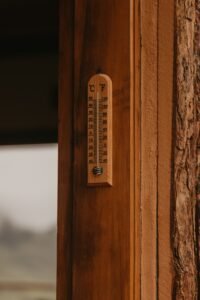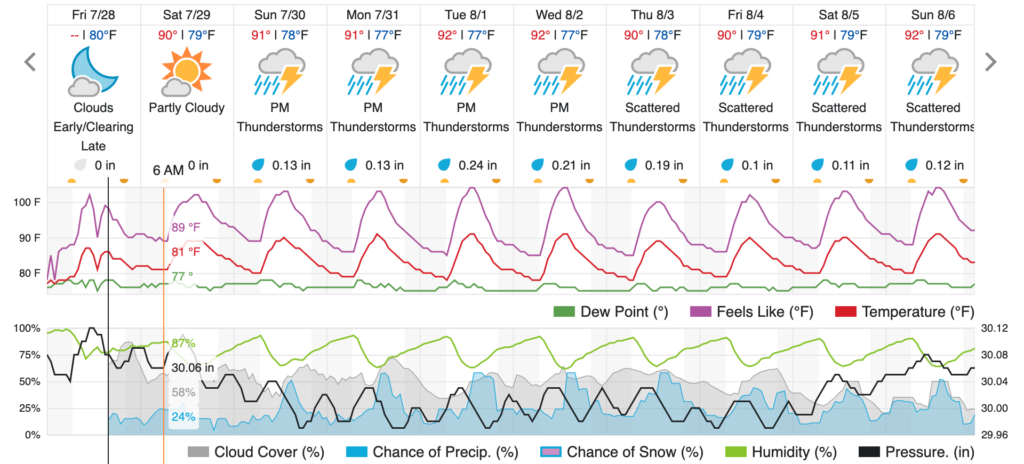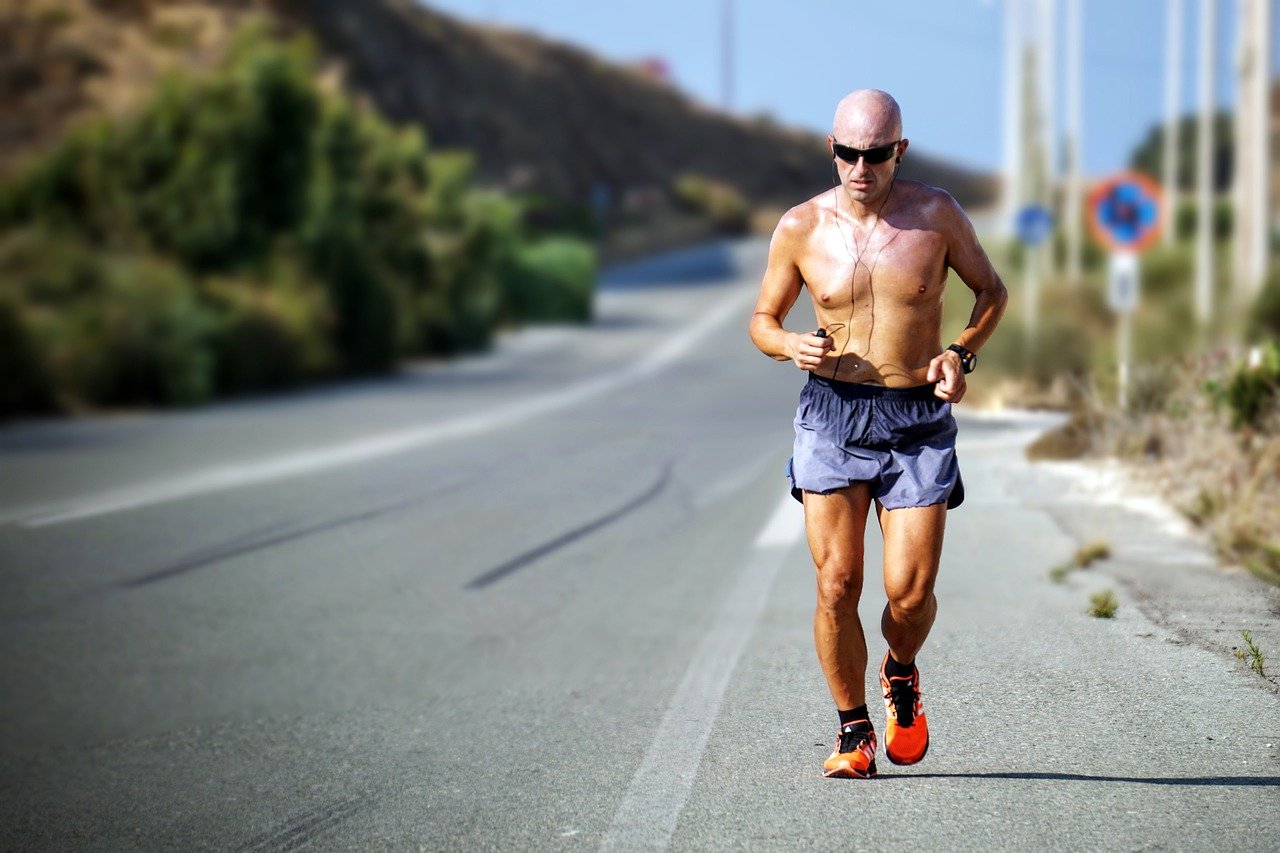It’s summer time here in New Jersey, and that means heat and humidity. The weather is subpar for running, and the months of July and August are typically pretty miserable.
It’s common knowledge that heat and humidity make running harder. But just how harder is it?
Recently, I spent some time in south Florida visiting family. As hot and humid as it is in New Jersey – it’s much worse down there. I was shocked by just how hard my runs were.
And so I thought it would be worthwhile to write up a quick post comparing my experience running in the Florida summer to running in the New Jersey summer.
Defining Weather Terminology

First, let me take a moment to define some weather terminology that you should know as a runner. These three metrics will help you look at the weather forecast and determine how good – or bad – the weather is that day.
The first is air temperature. This is the most obvious metric, and when you see a weather forecast this is probably the one number that you’re most likely to see.
Scientifically, this is known as the “dry bulb temperature.” It represents the air temperature taken outside in the shade. When it comes to running, high temps are bad. Anything above 70-80F will likely have an impact.
The second is relative humidity. This is a measure of how moist the air is. If you open up the weather app on your phone, you’ll almost always see this statistic. But it’s not as prominent as air temperature.
Relative humidity is reported as a percent. 100% relative humidity means that there is as much water vapor in the air as possible – and more water can’t evaporate into the air. Note that hotter air can hold more moisture – so as the temperature rises, the relative humidity tends to decrease. High humidity is bad when it comes to running.
The third is dew point. This is probably the most important single statistic you need to know – and it’s often hidden deeper in the forecast. It’s the temperature at which the air is fully saturated with water.
Remember that as temperature decreases, the amount of water vapor the air can hold also decreases. So if the same amount of water is in the air, and the temperature keeps decreasing, eventually it will reach 100% relative humidity. Essentially, dew point is the air temperature at which humidity will be 100%.
High temperatures with low humidity can be surprisingly pleasant to run in, because you can still sweat effectively. But high dew points are always bad – and even moderate temperatures with high dew points can make running difficult.
Summer Weather in Florida
If you’ve ever been to Florida in the summer, you know that it’s hot and it’s wet. When you get off the plane and step outside of the airport, the air will just feel heavy.
But exactly how bad is it? Take a look at this screenshot from Weather Underground.

This is the current forecast in West Palm Beach, but it’s pretty typical of what I experienced when I was there a couple weeks ago.
Starting with air temperature, the high each day is in the low 90’s and the overnight low each day is in the high 70’s. When I was there, it was around 80 every morning when I woke up before dawn.
The relative humidity fluctuates throughout the day. It’s the highest in the morning – around 90% – just before dawn. As the air temperature rises, it’ll decrease a bit to around 60-70%. A late afternoon thunderstorm might also help for a little bit. But overnight, the humidity will increase again.
Finally, the dew point is consistently high. On the chart, it looks low because the temperature and “feels like” temperature are so high. But the dew point is consistently 77 degrees – plus or minus a few degrees. When I was there, I don’t think it ever dropped below 75 degrees. And note how it stays constant throughout the day, despite the fluctuations in the relative humidity.
What’s It Like Running When the Dew Point is 75 to 80 Degrees?
So here’s the key question – what is it like running outside when the dew point is in the high 70’s?
It’s horrible.
I was in Florida for a week, and I went for seven runs. Over time, I acclimated to the heat a little bit – but it was never “comfortable.”
The first day, I planned to go for an easy 10 miles. I took a bottle of water. I planned to stop every two miles or so to walk a bit and drink some water. By the fourth mile, I was dying. I rode the struggle bus home, and in the last few miles I was only running two to three minutes before taking a walking break.
The next day, I again tried to run 10 miles. I planned a run-walk protocol from the beginning, with five minutes running and one minute walking. On the running portions, my heart rate quickly shot up and about seven miles in I needed an extended walking break. But I felt better than the day before.
The last three days were the best runs I had. I was able to run a consistent easy pace over 8 to 10 miles, with minimal walking breaks every two miles to drink some gatorade. My final three runs were as follows:
- 10 miles @ 9:28/mi, with an average heart rate of 137
- 8.5 miles @ 9:21/mi, with an average heart rate of 141
- 8.5 miles @ 9:21/mi, with an average heart rate of 139
My heart rate was under control. I typically try to stay around 135 to 140 for an easy run. But my pace was significantly slower than at home.
I was also drenched in sweat at the end of each and every run. I didn’t wear a shirt, but my shorts were dripping with sweat. About an hour into each run, my socks and shoes would be soaked through, and I could hear an audible “squish” with each stride.
Note that I woke up at 5:30 and left the house at 5:45 for each run. It was dark when I left, and around 80 degrees. The sun was typically just peaking over the horizon and through the clouds on my last couple miles.
Getting Back to the New Jersey Summer
I flew home from Florida, and the next day I ran a long workout outside. Things went pretty well, despite the fact that it was still hot and humid. But the overnight air temps were in the high 60’s and low 70’s, and the dew point was in the low 60’s.
That Saturday, I went for a run that offers a good comparison to my time in Florida. The temperature was in the low to mid 70’s – so not exactly “nice.” But the relative humidity was only around 60%. I slept in a little bit, so it was already 8am when I left and the sun was coming up. The dew point was around 59-60 degrees Fahrenheit.
I felt like I was flying. After the first mile warming up, my lap paces for the next six miles were 8:43 to 8:13. Throughout that first half, my heart rate was below 145 – a solid aerobic run. I picked up the pace a little bit at the end, but even with an average pace of around 8:00/mi for the second half, my heart rate only ticked up to 150-152.
Overall (including a ~2 minute bathroom break), I ran 11.75 miles at 8:32/mi, and my average heart rate was 143. So I ran further than I did in Florida, at a similar intensity, but my pace was a good 45 seconds per mile faster.
Also, I ended the run feeling great. I was a little sweaty, but neither my shirt, shorts, nor socks were soaked through. I only took an eight ounce handheld of water, and I wasn’t overly thirsty when I was done. If I hadn’t picked up the pace in the second half, I probably could have done a few extra miles without issue.
So What’s the Moral of This Story?
Dew point is your mortal enemy.
Living in New Jersey, I’m used to summer dew points in the low to mid 60’s. And if you asked me before, I would have said that was bad.
But after spending a week in Florida, running with dew points in the mid 70’s, I can tell you it gets much worse.
As a general rule of thumb, if the dew point is in the 70’s you’ll want to stick with easy running, hydrate well, and temper your expectations for duration.
When the dew point is in the 60’s, you can get away with a workout – but you’ll want to adjust your pace a little bit to compensate for the fact that your body will be working overtime to keep cool. Trying to run your normal paces is an easy way to blow up and end your workout early.
Dew points in the 50’s are pretty tolerable. As far as summer running goes, this is probably the best you can hope for. If you’re doing a race or a hard workout, you might want to adjust your paces slightly. But things aren’t nearly as bad as they are when the dew point is 60 plus.
If you spend the entire summer running in a place like Florida – I feel for you. I’d also love to hear about how you deal with the heat in the comments.
